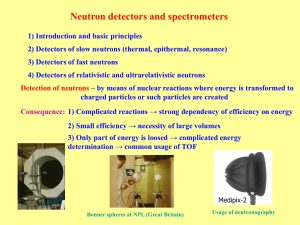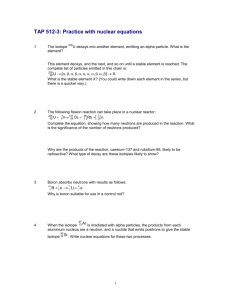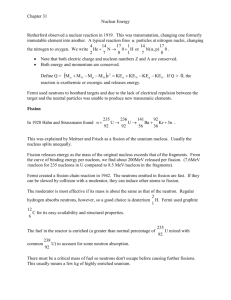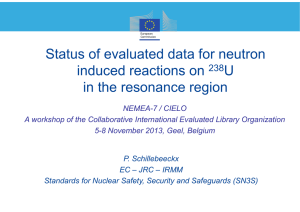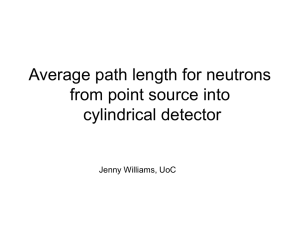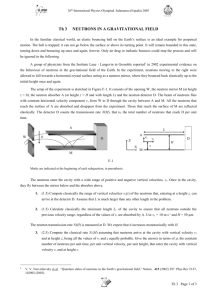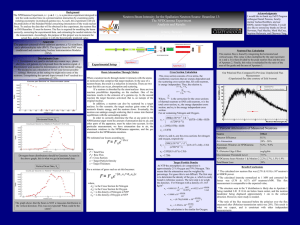STUDY ABOUT FISSION MEASUREMENTS AT GELINA
advertisement
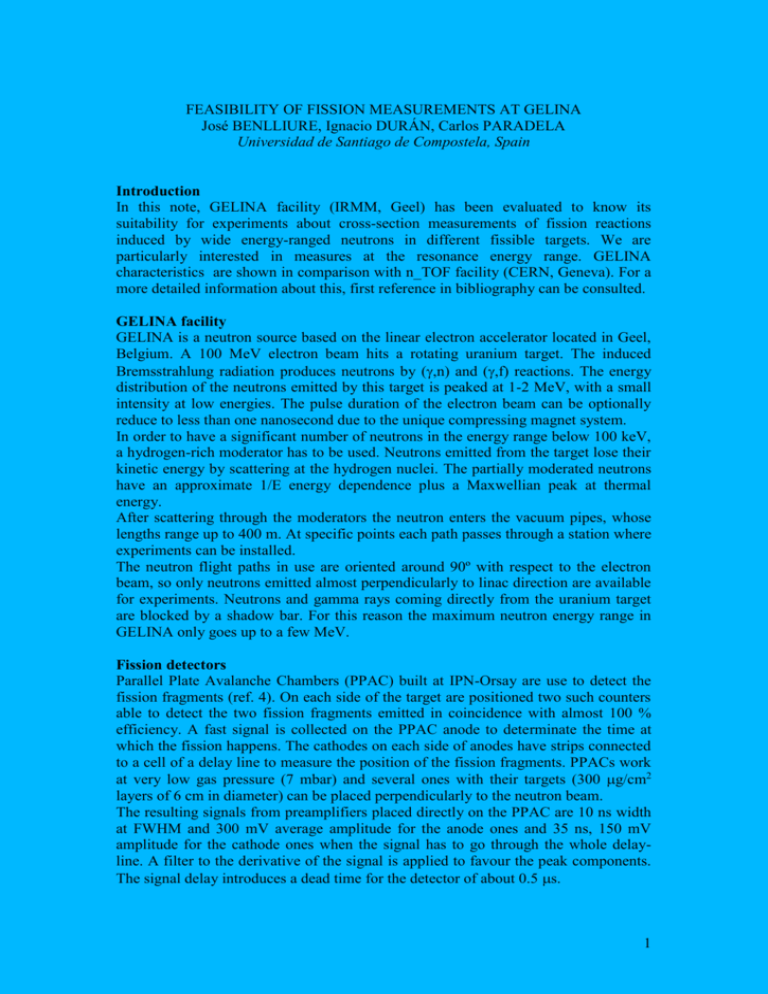
FEASIBILITY OF FISSION MEASUREMENTS AT GELINA José BENLLIURE, Ignacio DURÁN, Carlos PARADELA Universidad de Santiago de Compostela, Spain Introduction In this note, GELINA facility (IRMM, Geel) has been evaluated to know its suitability for experiments about cross-section measurements of fission reactions induced by wide energy-ranged neutrons in different fissible targets. We are particularly interested in measures at the resonance energy range. GELINA characteristics are shown in comparison with n_TOF facility (CERN, Geneva). For a more detailed information about this, first reference in bibliography can be consulted. GELINA facility GELINA is a neutron source based on the linear electron accelerator located in Geel, Belgium. A 100 MeV electron beam hits a rotating uranium target. The induced Bremsstrahlung radiation produces neutrons by (,n) and (,f) reactions. The energy distribution of the neutrons emitted by this target is peaked at 1-2 MeV, with a small intensity at low energies. The pulse duration of the electron beam can be optionally reduce to less than one nanosecond due to the unique compressing magnet system. In order to have a significant number of neutrons in the energy range below 100 keV, a hydrogen-rich moderator has to be used. Neutrons emitted from the target lose their kinetic energy by scattering at the hydrogen nuclei. The partially moderated neutrons have an approximate 1/E energy dependence plus a Maxwellian peak at thermal energy. After scattering through the moderators the neutron enters the vacuum pipes, whose lengths range up to 400 m. At specific points each path passes through a station where experiments can be installed. The neutron flight paths in use are oriented around 90º with respect to the electron beam, so only neutrons emitted almost perpendicularly to linac direction are available for experiments. Neutrons and gamma rays coming directly from the uranium target are blocked by a shadow bar. For this reason the maximum neutron energy range in GELINA only goes up to a few MeV. Fission detectors Parallel Plate Avalanche Chambers (PPAC) built at IPN-Orsay are use to detect the fission fragments (ref. 4). On each side of the target are positioned two such counters able to detect the two fission fragments emitted in coincidence with almost 100 % efficiency. A fast signal is collected on the PPAC anode to determinate the time at which the fission happens. The cathodes on each side of anodes have strips connected to a cell of a delay line to measure the position of the fission fragments. PPACs work at very low gas pressure (7 mbar) and several ones with their targets (300 g/cm2 layers of 6 cm in diameter) can be placed perpendicularly to the neutron beam. The resulting signals from preamplifiers placed directly on the PPAC are 10 ns width at FWHM and 300 mV average amplitude for the anode ones and 35 ns, 150 mV amplitude for the cathode ones when the signal has to go through the whole delayline. A filter to the derivative of the signal is applied to favour the peak components. The signal delay introduces a dead time for the detector of about 0.5 s. 1 Neutron flux There are three decisive factors that must be taken into account to explain the GELINA neutron flux: 1. The number of produced source neutrons which depends on the linac parameters: mean power, average electron energy, pulse repetition frequency, neutron pulse duration. Different values for these nominal operation parameters can be extracted from reference 2. For example, when 75 A, 100 MeV, 800 Hz and with pulse compression compression are used, 2.51013 s-1 neutrons are produced in the target, while n_TOF equivalent intensity, below 20 MeV, is 5.351014 s-1 (ref. 1). 2. Moderator affects directly the flux energy distribution. The spectrum emitted by n_TOF is more moderated than that of GELINA because the water moderator is 5 cm thick while the second one is only 3.6 cm. 3. Neutron flux decreases with the distance until the experimental area. Using data taken from GELINA papers (ref. 2) and internal n-TOF collaboration documents (ref. 3), we compare energy distribution of neutron flux for these two facilities in Figure 1. Figure 1. Comparison between GELINA neutron flux at 12.85 m (GELINA 1 in the plot) and 25 m (GELINA 2) and n_TOF flux at the first experimental area already in use at 187.5 m (TOF EA1) and the foreseen second one at 165 m (TOF EA2), in the energy range covered by GELINA. The neutron fluxes are calculated binning the energy spectrum in more than four hundred intervals of 1 % of energy. 2 Energy resolution In time-of-flight measurements, the kinetic energy (in MeV) of detected neutrons is deduced from a measurement of the flight path length, L (in meters) and the time of flight, T (in ns) by means of the classical formula E=1/2 (Mn/c2)(L2/T2) The energy resolution is defined by E/E = 2 [(L/L) 2+ (T/T) 2] 1/2 In a tof measurement, time and distances uncertainties are brought about by the characteristics of basic equipment, i.e. accelerator and target-moderator set-up detection system of the observed neutron reaction The reviewed documents (ref. 1,2) only do reference to first point and don’t supply the same type of resolution estimation: first reference gives us an energy resolution of 1.5 % for 1 MeV neutrons and 0.6 % for neutrons for neutrons in keV and eV range, while second one only supplies a spatial resolution for the facility in the energy range from thermal to 400 eV that it is equal to 0.3 %. Anyway, energy resolution is not as good as the one obtained at the n_TOF facility due to the shorter flight path, but it's good enough in the energy range where we want to perform our measurements. On the other hand, with PPACs it is possible to achieve a good timing resolution (250 ps), so uncertainty introduced by detectors ( >1% for MeV neutrons and >0.001% for eV ones) is less than the one due to the facility. Pile-up effect A possible problem that could appear is the pile-up in the resonance region. We checked the whole energy range for the measures, calculating the fission rate for each 1 % interval of energy, using a U-235 target, with 0.3 mg/cm² in thickness and 50 cm² area. Fission cross-section data are taken from MCNP libraries. The pile-up probability, considering a 1 s of dead time for detectors and electronics (main factor for dead time is the 0.5 s delay in cathode signal), is plotted in the figure 2. Pile-up numbers are far from significant ones for measurements, especially in resonance energy range. This pile-up estimation only includes signals due to fragments produced by time-correlated neutrons inciding the target. Facility background (as, for example, non-correlated neutrons scattered by walls) or noise in the detectors (for example, alpha particles crossing PPACs) hasn’t been considered. 3 Figure 2. Calculated fission pile-up for an experimental set-up 1 s dead time. As fission cross-section data was used a 414 data file in the energy range from 0.1 eV to 20 MeV taken from MCNP data tables for U-235. Experimental set-up and electronics In order to measure total cross sections, PPACs will be used in one of the GELINA experimental areas, where an intense neutron beam is available. As data acquisition we propose MBS environment (ref. 5) to operate a VME crate with a CES-RIOS8062 controller under Lynx-OS and a Multihit TDC. It is hosted by a PC under Linux where the disk storage unit is resident. Data are written in sequential files that can be analysed off-line. VME technology is a standard one in nuclear electronics and supplies enough data transfer rate. The CAEN V767A (ref. 5) is a 1-unit wide VME 6U module, which houses 64 independent time-to digital conversion channels. This module has a typical bin size (resolution) of 0.8 ns LSB (. Taking into account that 1 MeV neutron time-of-flight for a 12.85 m path is near 1 s, the time resolution we get is in the order of 1 % for most energetic neutrons in GELINA, and much better for slower neutrons. These numbers are comparable to the ones obtained for the experimental set-up resolution A dynamic range of 20 bits allows us, at typical 0.8 ns bin size, to record neutrons higher than 1.3 eV. To extend the energy range to lower energies, it is possible to operate with the TDC chip at lower resolution mode, so we reach until 1.6 ms ( = 0.3 eV), although actually it isn't able to get more than 1.250 ms (0.8 eV) in time for each pulse because this is the separation between pulses at 800 MHz beam frequency. About the separation between signals, the module features double hit resolution of 10 ns, much smaller than 1 s detector dead time foreseen. 4 Conclusion According to these explanations, for a specific target-moderator and fixed linac operation parameters and neglecting the effect of collimators and overlap filters, neutron flux dependence on flight path is clear: to get larger neutron intensities is convenient to use shortest flight paths. So it is recommended for the fission measurements at GELINA the use of the experimental area at 12.85 m from the target, the one with the shortest flight path available. The energy resolution is enough for our energy range and no pile-up problems are foreseen. Only the background information at 12.85 m should be evaluated in the future to validate the facility. The electronics proposed offer a suitable accuracy for PPAC signals timing, a width dynamic range to cover all the energy range requested and enough data transfer rate to run continuously at 800 MHz linac frequency. Bibliography 1. C. Coceva et al., On the figure of merit in neutron time-of-flight measurements, Nucl. Instr. Meth. A, in press. 2. Frank Gunsing Thesis 3. S. Andriamonje et al., Neutron TOF Facility (PS 213),Technical Design Report, CERN Report CERN/INTC/2000-004,2000. 4. Claude Stephan et al, Neutron-Induced Fission Cross Section Measurements between 1 eV and 250 MeV, internal paper. 5. http://daq.gsi.de/ 6. V767A User's Manual, www.caen.it 5



